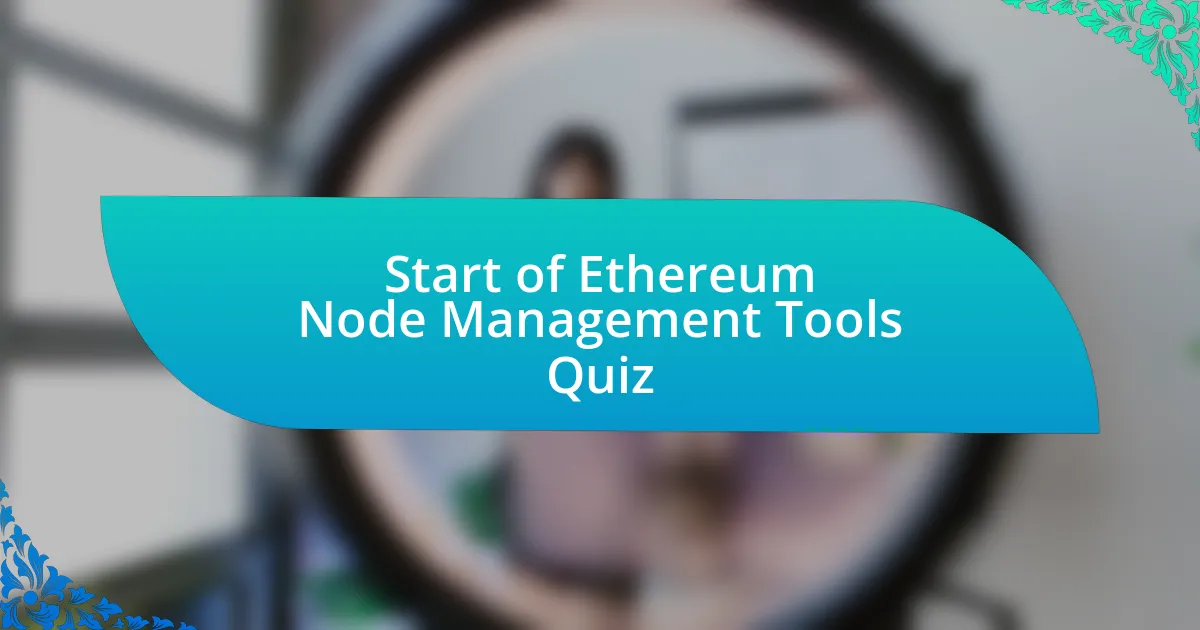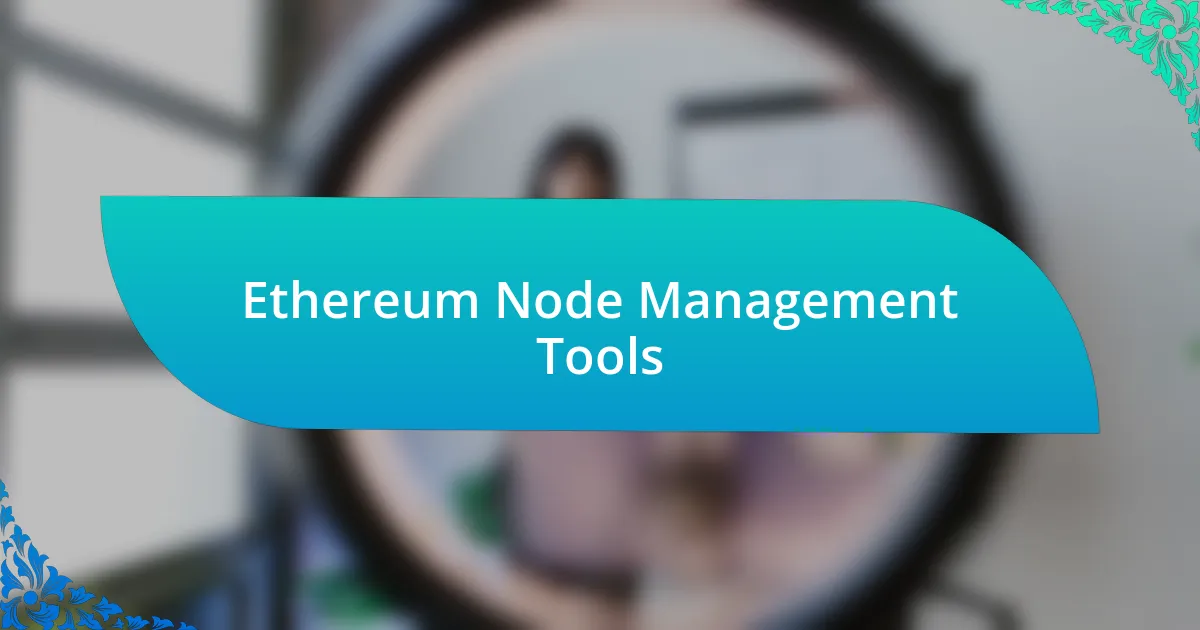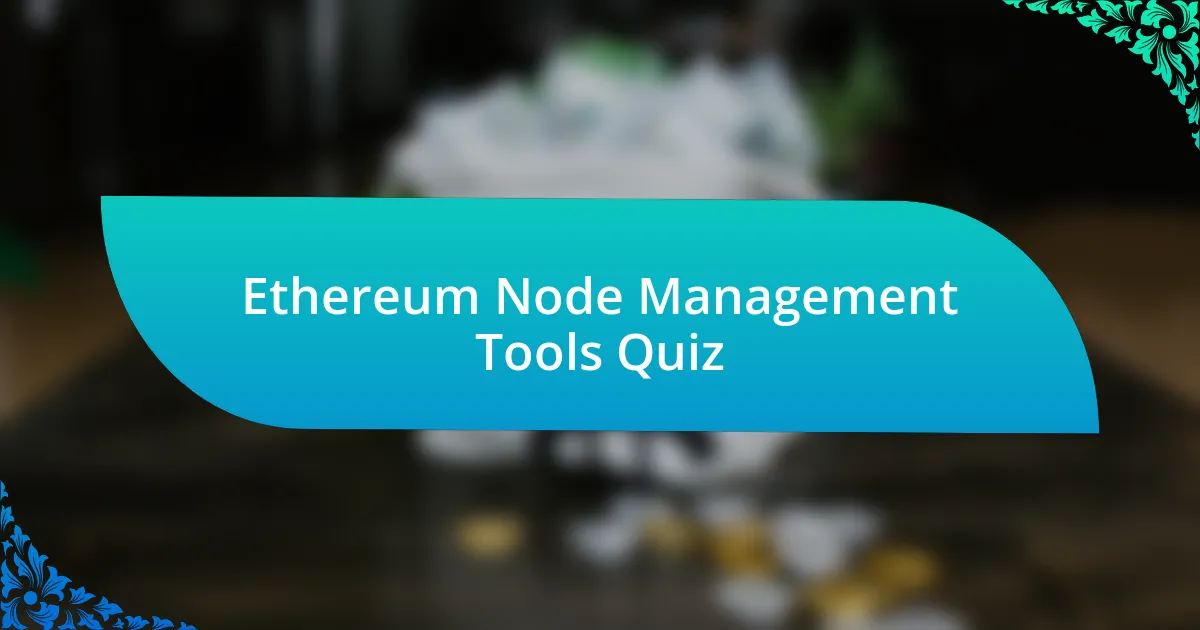
Start of Ethereum Node Management Tools Quiz
1. What is the primary function of an Ethereum node?
- To manage user accounts in Ethereum wallets.
- To store and validate transactions on the Ethereum network.
- To generate smart contracts automatically.
- To create new Ethereum clients for developers.
2. What is the difference between a full node and a lightweight node?
- A full node creates new transactions, while a lightweight node does not participate in the network.
- A full node only validates transactions, while a lightweight node stores all blockchain data.
- A full node connects to other users, while a lightweight node operates independently without network connections.
- A full node stores the complete history of all transactions, while a lightweight node verifies transactions by piggybacking on the work of full nodes.
3. What is the purpose of a Merkle node in Ethereum?
- To ensure smart contracts execute efficiently on the network.
- To help the network restore itself to its last valid block through Merkle tree roots.
- To manage user accounts and wallet functionalities in transactions.
- To store and serve user-generated data on the Ethereum blockchain.
4. How do miners secure the Ethereum network?
- By creating new wallets for each miner.
- Through automated trading systems to increase profits.
- Through incentivization, where miners receive currency for securing the network.
- By centralizing control over the entire network.
5. What is the role of miners in a blockchain network?
- Miners store user data and manage account balances in a blockchain network.
- Miners design network protocols and set rules for transaction fees in a blockchain network.
- Miners act as computers that validate transactions and add them to the blockchain, ensuring the integrity of the network.
- Miners create and control smart contracts on the blockchain.
6. What is the function of a beacon node in Ethereum?
- To participate in the consensus process by proposing and attesting to blocks.
- To store the transaction history on the blockchain.
- To execute smart contracts directly on the network.
- To manage user wallets and private keys efficiently.
7. What is the purpose of a validator client in Ethereum?
- To create smart contracts and manage their executions.
- To manage validator keys and propose and attest to blocks.
- To store all transactions permanently on the blockchain.
- To provide access to the Ethereum network through a user interface.
8. What is the difference between an execution client and a consensus client?
- An execution client connects users to the blockchain, while a consensus client executes smart contracts.
- An execution client manages validator keys, while a consensus client stores all historical transactions.
- An execution client executes transactions in the EVM and holds the latest state and database of all Ethereum data, while a consensus client participates in the consensus process.
- An execution client validates cryptographic signatures, while a consensus client handles user authentication.
9. What is Go Ethereum (Geth)?
- Go Ethereum (Geth) is a graphical interface for creating smart contracts.
- Go Ethereum (Geth) is the official Golang implementation of the Ethereum protocol and the most popular Ethereum client.
- Go Ethereum (Geth) is a hardware wallet for storing Ethereum securely.
- Go Ethereum (Geth) is a mobile application for trading cryptocurrencies.
10. What is Hyperledger Besu?
- Hyperledger Besu is an Ethereum wallet for storing cryptocurrency.
- Hyperledger Besu is an open-source Ethereum client developed with Java and operates on both public and private networks.
- Hyperledger Besu is a mining software used for mining Ethereum.
- Hyperledger Besu is a blockchain protocol designed exclusively for private companies.
11. What is Nethermind?
- Nethermind is a smart contract development framework for Ethereum.
- Nethermind is a decentralized application for trading cryptocurrencies.
- Nethermind is a hardware wallet for storing Ethereum securely.
- Nethermind is an open-source Ethereum client licensed under the LGPL-3.0 and written in the C# .NET tech stack.
12. What is Nimbus?
- Nimbus is an Ethereum consensus client designed to efficiently use resources, enabling high-performance operation on lightweight devices.
- Nimbus is a cryptocurrency wallet specializing in secure storage solutions.
- Nimbus is a blockchain service for creating smart contracts on multiple platforms.
- Nimbus is a decentralized exchange focused on trading Ethereum-based tokens.
13. What is Teku?
- Teku is a mobile application for managing Ethereum wallets.
- Teku is a type of decentralized exchange for trading cryptocurrencies.
- Teku is an Ethereum-based game that allows players to earn tokens.
- Teku is an open-source Ethereum consensus client written in Java containing full beacon node implementation and a validator client.
14. What is the purpose of EthPillar?
- EthPillar is a wallet application for securely storing Ethereum assets.
- EthPillar is a decentralized exchange for trading Ethereum tokens.
- EthPillar is a tool for deploying and managing Ethereum nodes, including setting up validator clients and managing failover staking nodes.
- EthPillar is a library for optimizing transaction gas fees on Ethereum.
15. How do you connect to an Ethereum node?
- You can connect using POP3, IMAP, or VPN.
- You can connect to an Ethereum node using WS-RPC, JSON-RPC, or IPC-RPC.
- You can connect using FTP, SSH, or SMTP.
- You can connect using USB, HDMI, or Bluetooth.
16. What is the function of a JSON-RPC API in Ethereum?
- The JSON-RPC API provides a standardized interface for interacting with Ethereum nodes, allowing developers to execute commands and retrieve data.
- The JSON-RPC API is used for creating user interfaces for Ethereum wallets without any command execution.
- The JSON-RPC API is responsible for initiating smart contracts based on user preferences.
- The JSON-RPC API acts solely as a data storage mechanism for Ethereum transactions.
17. What is the purpose of a command-line interface (CLI) in Ethereum?
- The CLI provides a user-friendly interface for running, maintaining, debugging, and monitoring Ethereum nodes.
- The CLI is primarily for trading Ethereum in exchanges.
- The CLI is used for creating smart contracts on Ethereum.
- The CLI serves as a wallet to store Ethereum tokens.
18. What is the role of a Prometheus/Grafana dashboard in Ethereum?
- The dashboard serves as a wallet for storing Ethereum cryptocurrency.
- The dashboard generates smart contracts for Ethereum applications.
- The dashboard creates new Ethereum tokens for blockchain projects.
- The dashboard provides monitoring and analytics tools to track the performance and health of Ethereum nodes.
19. How do you deploy a full node using Geth?
- You can deploy a full node by using a local file storage and manually modifying configuration files.
- You can deploy a full node using an SQL database and connecting through an API.
- You can deploy a full node by programming it in Python and using a web server.
- You can deploy a full node using Geth by installing it with a package manager, running it as a Docker container, or constructing it from scratch.
20. What is the purpose of a failover staking node in Ethereum?
- A failover staking node optimizes transaction speed by reducing latency across the network.
- A failover staking node increases the gas fees for Ethereum transactions to improve security.
- A failover staking node functions as a mining rig to generate new Ether continuously.
- A failover staking node provides high availability by running two or more nodes on separate machines, ensuring continuous operation in case one node fails.
21. How do you configure a Nimbus validator client?
- You configure a Nimbus validator client by connecting it to the Bitcoin network instead of Ethereum.
- You configure a Nimbus validator client by using only graphical user interface tools without any coding.
- You configure a Nimbus validator client by editing the validator client configuration and setting up beacon nodes and validator keys.
- You configure a Nimbus validator client by writing a blockchain from scratch and deploying it manually.
22. What is the purpose of a port checker in EthPillar?
- The port checker in EthPillar speeds up transaction processing by prioritizing certain network connections.
- The port checker in EthPillar helps identify common issues preventing the node from optimal performance by checking port availability.
- The port checker in EthPillar creates new Ethereum tokens for network users to trade.
- The port checker in EthPillar encrypts data to secure transactions and user information.
23. What is the purpose of automated system benchmarking in EthPillar?
- Automated system benchmarking in EthPillar is used to build user interfaces for applications.
- Automated system benchmarking in EthPillar helps discover common issues by running automated tests to assess the node`s performance.
- Automated system benchmarking in EthPillar serves to encrypt sensitive transactions on the network.
- Automated system benchmarking in EthPillar is aimed at creating new Ethereum nodes automatically.
24. How do you deploy a Solo Staking Node using EthPillar?
- You configure a Solo Staking Node by compiling the source code and connecting to a pool.
- You launch a Solo Staking Node by downloading the Ethereum blockchain and running it locally.
- You deploy a Solo Staking Node using EthPillar by navigating to the relevant configuration options and setting up the necessary validator keys and nodes.
- You set up a Solo Staking Node by using a web interface to create smart contracts on the network.
25. What is the purpose of a Lido CSM Staking Node in Ethereum?
- A Lido CSM Staking Node is a server only for transaction processing on the Ethereum network.
- A Lido CSM Staking Node is a mining rig for generating new Ether in the Ethereum blockchain.
- A Lido CSM Staking Node is a type of staking node that integrates with Lido`s decentralized staking service, providing a secure and efficient way to stake Ether.
- A Lido CSM Staking Node is used exclusively for developing decentralized applications in Ethereum.
26. How do you recover an Ethereum account with no private key?
- Use the 12-word mnemonic phrase set during account creation.
- Contact a friend who has your wallet address for recovery.
- Reset your email password linked to your Ethereum account for access.
- Submit a ticket to Ethereum support for account recovery.
27. What is the purpose of a JSON-RPC gateway in Ethereum?
- The JSON-RPC gateway allows running multiple Ethereum nodes for redundancy and load-balancing purposes, providing a centralized interface to manage multiple nodes.
- The JSON-RPC gateway enhances the speed of transaction execution on the Ethereum network.
- The JSON-RPC gateway is used to create and deploy smart contracts directly on the Ethereum blockchain.
- The JSON-RPC gateway generates unique wallet addresses for Ethereum users automatically.
28. What is the purpose of Eventeum in Ethereum?
- Eventeum is a client for running Ethereum nodes without a blockchain.
- Eventeum is a tool for mining Ethereum more efficiently and rapidly.
- Eventeum is a bridge between Ethereum smart contract events and backend microservices.
- Eventeum is a wallet application for managing Ethereum assets securely.
29. What is the purpose of Marmo in Ethereum?
- Marmo is a consensus algorithm for securing Ethereum transactions.
- Marmo is a set of SDKs for simplifying interactions with Ethereum, using relayers to offload transaction costs and improve efficiency.
- Marmo is an Ethereum mining pool that maximizes hash power.
- Marmo is a type of Ethereum wallet for storing cryptocurrencies.
30. What is the purpose of Watchdata in Ethereum?
- Watchdata is an Ethereum mining pool for high rewards.
- Watchdata is a user interface for Ethereum trading platforms.
- Watchdata provides simple and reliable API access to the Ethereum blockchain.
- Watchdata offers tools for creating Ethereum smart contracts.

Quiz Completion: Congratulations!
You’ve successfully completed the quiz on Ethereum Node Management Tools. This journey has likely enriched your understanding of various tools and techniques essential for managing Ethereum nodes effectively. As you navigated through the questions, you may have discovered insights into the importance of both performance and security in node management.
Throughout the quiz, you learned about different software options, configurations, and best practices. Each question aimed to deepen your familiarity with the tools that enhance node stability and efficiency. Gaining this knowledge is crucial for anyone keen on optimizing their Ethereum experience.
Now that you’ve tested your knowledge, we encourage you to check the next section on this page. It offers more in-depth information on Ethereum Node Management Tools. Expanding your knowledge will empower you to make informed decisions in your Ethereum projects. Let’s dive deeper into this fascinating topic together!

Ethereum Node Management Tools
Overview of Ethereum Node Management Tools
Ethereum node management tools are software applications designed to facilitate the administration and operation of Ethereum nodes. These tools provide functionalities such as node monitoring, synchronization management, and performance optimization. By using these tools, developers and operators can ensure their nodes are running efficiently, securely, and in alignment with the Ethereum network protocols. The importance of these tools lies in their ability to streamline node operations, reducing the manual effort required to maintain a healthy node.
Common Features of Ethereum Node Management Tools
Common features of Ethereum node management tools include node monitoring, log management, alerting systems, and performance analytics. Monitoring allows users to track node health, while log management helps in troubleshooting issues. Alerting systems notify operators of problems, and performance analytics provide insights into node efficiency and resource utilization. These features are crucial for maintaining node uptime and performance in the Ethereum network.
Popular Ethereum Node Management Tools
Popular Ethereum node management tools include Geth, Parity (now OpenEthereum), and Infura. Geth is the Go implementation of Ethereum that includes tools for node management. Parity offers advanced features tailored for developers. Infura provides a hosted Ethereum node service, allowing users to interact with the Ethereum network without having to manage a node themselves. Each of these tools caters to different user needs, from developers to enterprises.
Comparative Analysis of Node Management Tools
A comparative analysis of Ethereum node management tools reveals differences in usability, performance, and community support. Geth is widely recognized for its strong community and rich documentation, making it user-friendly for beginners. In contrast, OpenEthereum boasts faster synchronization times and advanced features suited for professional developers. Infura removes the need for direct node management, appealing to those prioritizing simplicity over control. This analysis assists users in selecting the appropriate tool for their specific requirements.
Future Trends in Ethereum Node Management Tools
Future trends in Ethereum node management tools include increased automation, enhanced security features, and integration with decentralized finance (DeFi). Automation aims to reduce manual intervention, improving node upkeep efficiency. Enhanced security measures focus on safeguarding nodes against potential threats. Additionally, integration with DeFi applications will allow for more seamless interactions between nodes and emerging decentralized ecosystems. These trends are shaping the future landscape of node management within the Ethereum network.
What are Ethereum Node Management Tools?
Ethereum Node Management Tools are software applications that allow users to interact with and manage Ethereum nodes. These tools facilitate efficient operation, configuration, and monitoring of nodes in the Ethereum network. Examples include Geth, OpenEthereum, and Besu, which provide functionalities such as network connection management and synchronization monitoring.
How do you use Ethereum Node Management Tools?
To use Ethereum Node Management Tools, a user typically installs the software on their system and configures it according to their needs. This may involve setting parameters such as peer connections and syncing options. Once configured, the tool connects to the Ethereum network, allowing for node operations, transaction sending, and blockchain querying.
Where can you find Ethereum Node Management Tools?
Ethereum Node Management Tools can be found on official project websites, GitHub repositories, or package managers like npm and Homebrew. These platforms host the latest versions and documentation for installing and using the tools effectively.
When should you use Ethereum Node Management Tools?
Ethereum Node Management Tools should be used when setting up a new Ethereum node, participating in network validation, or developing decentralized applications (dApps). They are essential for maintaining synchronization with the blockchain and ensuring the node runs efficiently under various network conditions.
Who uses Ethereum Node Management Tools?
Ethereum Node Management Tools are used by Ethereum developers, validators, and system administrators. They help these users manage the infrastructure required for decentralized applications and blockchain interactions, ensuring proper functioning and connectivity within the Ethereum network.

